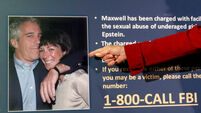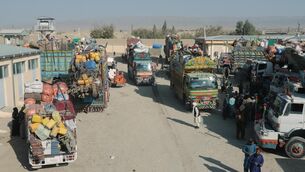Rescuers drill third hole in bid to find trapped miners
Rescuers are to drill a third hole in a bid to locate six trapped Utah miners after a video camera revealed equipment, but no men.
Poor lighting allowed the camera to see only about 15 feet into a void at the bottom of the drill hole, far less than the 100 feet it was capable of seeing, said Richard Stickler, head of the Mine Safety and Health Administration.
Rescuers saw a tool bag, a chain and other items normally seen underground in a mine, he said, but “we did not see any sign at all of any of the miners”.
That view was recorded on the camera’s second trip down the hole. On its first descent on Saturday, in which one lens was impaired, the camera showed a and a half foot-high void described by Stickler as “survivable space”.
The men have not been heard from since the mine near Huntingdon was struck by an earthshaking collapse early last Monday. Rescue leaders said they were proceeding as if the miners were alive.
“Our attitude is we always have to have hope, and our position is that we’re hoping and we’re praying and it would be a terrible mistake to give up hope until you know for sure,” Stickler said.
Another attempt to see further in the mine will be made with an improved lighting system, Stickler says. In between using the camera, compressed air is being pumped down the hole into the mine.
The drill rig will be relocated to a new position where it will send the drill down 1,414 feet. The previous holes were more than 1,800 feet.
Bob Murray, head of Murray Energy, co-owner of the mine, said the new hole would target an area that the miners would have gone if air in their original location was bad.
Stickler would not estimate how long it would take to drill the new hole. Murray initially estimated three to four days, but his vice president, Rob Moore, said quietly to him during a news conference that it could be up to six days.
At the time of the collapse, the miners were believed to be working at a point 3.4 miles from the Crandall Canyon mine entrance.
Rescuers have also been slowly moving horizontally through the mine to try to reach the men.
The horizontal route was blocked about 2,000 feet from the men. Rubble had been cleared from about 580 feet of that route, Stickler said. The distance had been estimated at 650ft yesterday. The discrepancy was not immediately explained.
Councilwoman Julie Jones, who was with the families when they were briefed, said they were very hopeful.
Of the miners’ relatives, she said, “They are one family.”
Mike Marasco, son-in-law of missing miner Kerry Allred, said his family had been sleeping on the floor of the school where families were gathering to somehow identify with their father’s discomfort inside the mine.
“It’s hard to just sit here. We want to feel what he felt. We’ve been sleeping on the floor … it’s not even close to being in the mine but it’s something,” he said.
The cause of the collapse has not been officially established.
Murray has insisted that the collapse was caused by an earthquake, but seismologists say there was no earthquake and that readings on seismometers actually came from the collapse.













